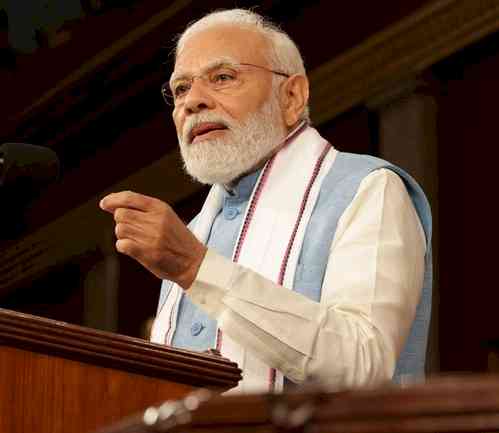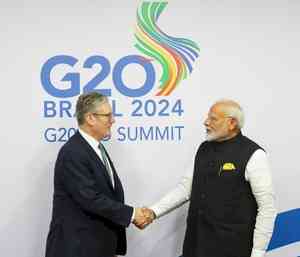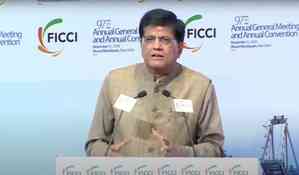Authenticity is the defining trait of a successful leader (Column: The Third Eye)
A leader by definition is a person who has followers - big or small in number - looking up to him or her for guidance and wanting to emulate the example set by the leader through 'decisions' and 'actions'. This holds good in all spheres including the professional arena and public life.

D.C. Pathak
New Delhi, July 9 (IANS) A leader by definition is a person who has followers - big or small in number - looking up to him or her for guidance and wanting to emulate the example set by the leader through 'decisions' and 'actions'. This holds good in all spheres including the professional arena and public life.
Authenticity is a product of intellectual strength, personal integrity, courage of conviction, informed approach, effective communication, selflessness and an understanding of human nature - it is not only about 'looks', 'sartorial' elegance or display of 'physical' prowess.
Swami Vivekanand combined a magnetic personality with the power of thought but it is what he communicated to the people in that famous Chicago speech in 1893 at the platform of the Parliament of Religions that left a lasting imprint on the world at large and made him perhaps the best presenter of the ‘Idea of India’ to date as a ‘leader’ of this nation.
Adherence to a given value system, knowledge-based decision making, smooth interaction based on good articulation, ability and nerves to ride a challenge, trustworthiness in the eyes of the followers rooted in the fulfilment of promises made, clarity about sharing credits, and personal honesty constitute the ‘package’ that sustains a leader through the thick and thin in the life of the nation or the organisation as the case might be. It is the power of authenticity that makes a leader strong and effective.
In public life leadership turns into a short-lived affair for the reason that among other things ‘Party politics’ came in the way of a consistent practice of what was good and diluted the sense of commitment to a cause.
It is the declared ‘vision’ of an organisation that helps its CEO to ensure that all members adhered to the ethics and values characterising the pathway to that mission. This lends a certain transparency to the leadership itself and adds to the credibility of the Chief. A lot however will depend on the ‘authenticity’ that the leader brings to bear on his or her personal image and conduct by taking decisions without tints or favouritism - based on reliable and complete-looking knowledge.
The leader has to remain 'well informed' and that too in an ongoing fashion about the situation within the establishment and in the business world outside. The test is that the leader should have information that made a difference between a 'decision' and a 'guess' and this applies also in matters of boss-subordinate relationship that could be easily spoiled if the senior did not care to keep himself reasonably informed of the situation of the junior both at work and at home.
The exercise of emotional intelligence comes in handy for the leader in retaining the organisational and personal loyalty of the followers.
A successful leader is accessible, strict but nurtural towards the people working for him and is careful not to let a gulf develop between his proclamations and actions or between his promise and its fulfilment. It is in public life that leadership gets discounted on these parameters - this often happens for reasons of ‘political’ compulsion.
The appearance of Prime Minister Narendra Modi on the national scene in 2014 was - keeping BJP’s organisational situation apart - made possible essentially because of his personal integrity and a public perception that he handled governance with a strong hand.
In a situation where people were distressed by ineffective governance and widespread corruption, he seemed to offer the right option.
Significantly down the line Prime Minister Modi has in these nine years earned praise for his policies and ran into criticism for some of his decisions but what sustained his leadership was the faith that existed in the above-mentioned two basic traits - personal integrity and ability to run the administration with a strong hand - that people wanted to see in a national leader. His intentions about doing good to the people and the nation have not been in doubt and this is a huge asset for a leader in politics in a situation where the findings of the Vohra Committee report about the ‘nexus’ between politicians, bureaucrats and ‘criminals’ were still casting shadows on the country’s public life.
Prime Minister Modi's bold and big thinking on national economic and security issues was in evidence during his recent US visit - the wide range of agreements that were reached between the two countries on the occasion proved that.
It is the 'authenticity' of Prime Minister Modi's leadership of the world's largest democracy that enabled him to present India as an equal partner of the US in the endeavour to create a safer and economically better world.
The fundamentals of successful leadership - ‘initiative’ to launch projects of public good, political will attributable to one’s ‘courage and nerves’, personal ‘integrity’ rooted in his humble background, absence of ‘family’ interests and determination to check corruption, ‘communication’ with the people and ‘commitment’ and hard work for the cause of national security and growth - are adequately in evidence in his case and it is no surprise that ‘wisdom of the crowd’ continued to work in favour of Prime Minister Modi.
In a long time, India has a leader with a demonstrable commitment to the nation, personal integrity and consonance between his policies and their execution.
Since a leader is there because of the people who work for him, all aspects of connectivity between the two determine the success of the former.
The power of communication flows from a grid of understanding established by the leader within the corporate body, clarity of the language used in any communication and the environment of human empathy prevailing in the organisation. The entire range of practices that made a team result-oriented had to be in place - recognition of an individual as the centre of productivity, tradition of giving and taking help and a convincing transparency about credit sharing, are important.
The leader should be available for giving guidance where needed within the operation of vertical hierarchy and juniors should be free to consult the team leader whenever they felt stuck on a point. This in fact is the tradition in an Intelligence organisation where the feeling that all worked together runs deep and it is acknowledged that success at every step - big or small - determined the final outcome.
A successful leader gets the interpersonal relationships right within the workforce mentored by him or her. In a competitive environment, this may decide the advantage one organisation would have over others.
Acceptability of a leader among his people - over and above his professional merits - is crucial for his success but this is not something that could be easily predicted. However, it is a fact that it had something to do with the authenticity of the person at the top - which in turn would be determined by his trustworthiness, image of honesty and humane outlook.
Leadership today is first tested in the way a senior treats the juniors reporting to him - this incidentally goes a long way in shaping the morale and performance of the organisation as a whole. The role of a ‘boss’ cannot be fulfilled by an individual who did not have an essence of leadership in him. A leader worked out of inner confidence or self-esteem and not ego because the latter more often than not, was traceable to the external factor of ‘power’ associated with the ‘position’ enjoyed by him within the organisation.
A boss who was also a leader would realise while dealing with his people that no two persons were equal in every respect, that ‘hard work’ is as important as ‘brilliance’ and that emotions often shaped the responses of a subordinate - sometimes circumstances outside the place of work may have affected the latter. That a safe and peaceful environment at the workplace is conducive to productivity and that there is a certain importance of ‘work-life’ balance is understood by a successful leader.
It is the right of the ‘boss’ to find fault with the output of the individual working for him but in the process, there should be no attack on the ‘character’ of the subordinate - this kind of personal denunciation happens quite often. So long as a junior had a say in a discussion on an idea to be implemented, he should be willing to abide by the decision taken by the leader who had to take responsibility for the same.
Only a ‘boss’ without merits tries to perfect the art of ‘escapism’ for averting any blame for anything going awry in his set-up.
Further, with the new-found importance of ‘time’ in today’s world, a leader must know how not to allow a gap between a decision and its communication below and between the communicated decision and its implementation.
In the final analysis, it can be said that the success of a leader is defined by a combination of prerequisites which if satisfied, would help the individual to lead in any sphere of responsibility. A leader is only notionally defined by the position he holds or the status he commands for it is the essential traits of leadership he had that would set his performance and organisational utility.
A leader can manage but a manager can not always lead and though both would need a certain grooming and would benefit from experience, there is substance in the belief that a leader had some in-born human qualities beyond intelligence and acquired professional skills.
Principally, knowledge of the human psyche, emotional intelligence, personal integrity, commitment to a value system and willingness to take initiative, are the defining traits of a successful leader - beyond an information-based approach and courage to ride through a change compelled by the external environment. Obviously, an indecisive person can never be a good leader nor can a leader given to ‘stealing’ credits command respect that is due for the top man.
It is now widely accepted that a true leader nurtures his workforce and sets an example before his men for productivity, application and humane dealings.
On the whole, it is the authenticity accruing from a combination of traits that makes for a successful leader. Even in political life authenticity of a leader gives him or her a lasting image and reputation even if contingencies of politics may limit the tenure of the position of power held by the individual.
There is a paucity of leaders in our public life probably because people come into politics for the gains of office, not for the motivation of public service that had to be a voluntary vocation. This vulnerability to personal benefit can destroy authenticity - which is directly linked with the ‘character’ of the man - and obscure any other leadership material the person might have been endowed with.
An upright man wins half the battle for leadership if he fulfils all personal prerequisites - his only other requirements are proficiency, decisiveness and a knowledge-based outlook. All of this together gives him the power of authenticity that provided the stratum for leadership.
A leader with a humane approach, confidence in his ability to take initiative and commitment to the higher goal of the organisation would easily command an image of authenticity that was in one word the hallmark of successful leadership.
(The writer is a former Director of the Intelligence Bureau. Views expressed are personal)


 IANS
IANS 












